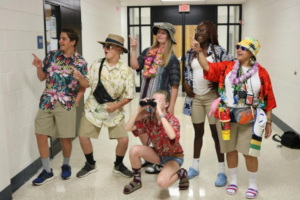Confirmation Progymnasmata
Jonathan Culler puts out a very interesting piece regarding travelers versus tourists. I have read numerous pieces for this class thus far regarding tourism and the negatives surrounding it. So far, we have read about the appropriation of cultures through and the degradation of environments in certain countries due to overpacking tourists. However, I found myself disagreeing with many of the points suggested as I did not think all people traveled for the sole purpose of seeing the “big” tourist attractions. I argued in previous pieces how it was lazy to stereotype all tourists into one category as the ones who have no intention of learning the culture of the place, they travel to but rather see something, take a picture, and then leave. At my high school we used to have a spirit week where one of the days were tacky tourist day, this reminds me of slapping a stereotype on a group. Here is a picture for reference:
 Culler does a good job and splits these two types of people, travelers and tourists.
Culler does a good job and splits these two types of people, travelers and tourists.
Culler describes the difference in these two by talking about the semiotics of travel. Tourists are those who are not interested in what the culture has to offer but rather the idea of what their culture has to offer. Culler describes it perfectly, “The French chanteuse singing English with a French accent seems more charmingly French than one who simply sings in French” (Culler). These tourists are not interested in what France has to offer culturally, but rather what the perceived image of France has to offer, hence French people speaking English with French accents rather than actually speaking French. Then, the traveler is one who goes to various destinations for getting lost in that nation. As stated in the reading, “to drive through Roumania or Afghanistan without hotel reservations and to get by on terrible French” (Culler). Travel has become too much of becoming something you are not, such as traveling to a foreign country to become part of a social class that you are not part of back home or to simply take pictures of nice locations to brag about on social media. This piece is logical as it describes the fine line that differentiates the stereotypical “tourist” versus the more serious “traveler.” Culler has in-depth reasoning as to why both exist, the issues that arise from tourism, and why becoming a traveler needs to become the new normal so cultures do not get degraded.

